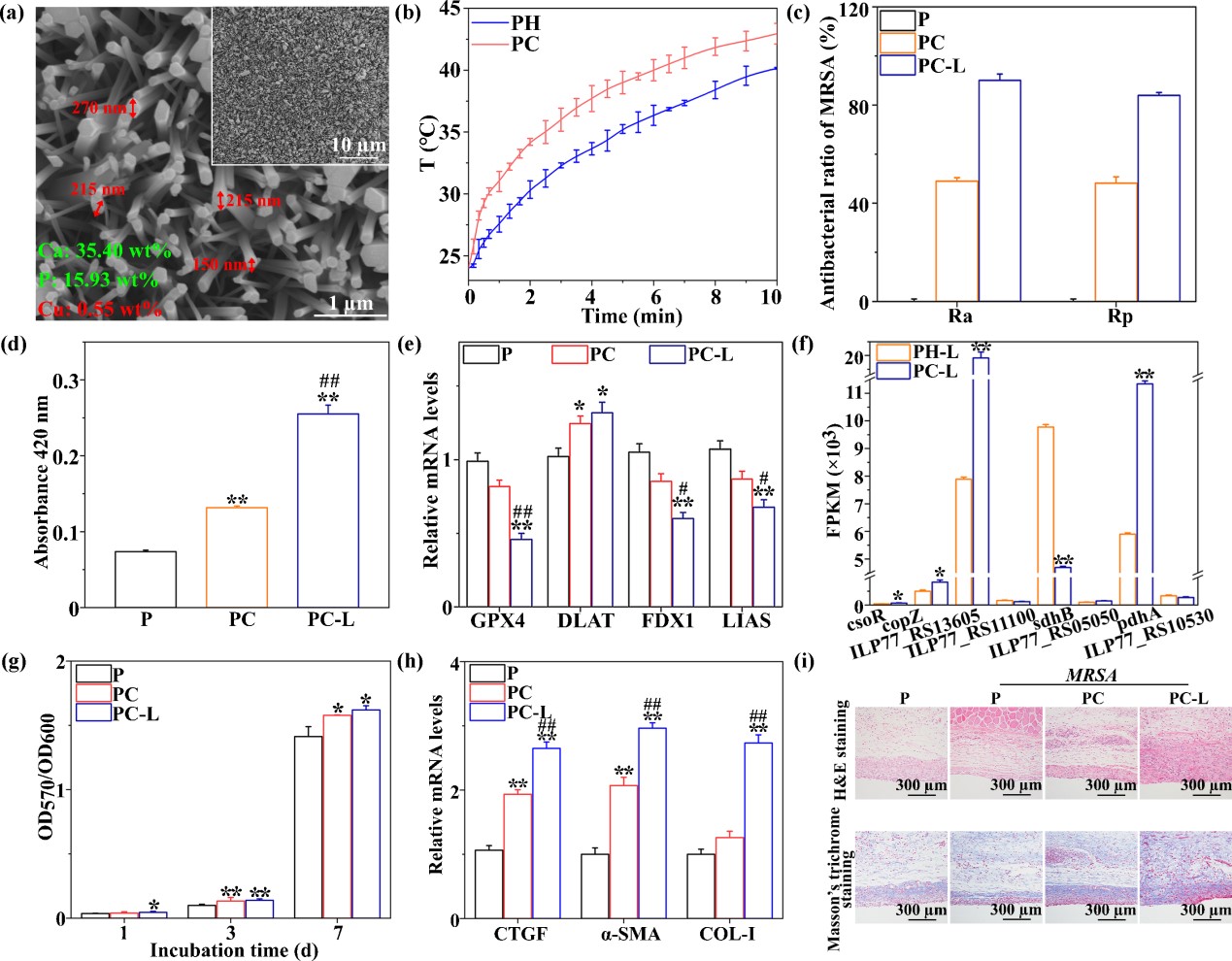Methicillin-resistant Staphylococcus aureus (MRSA) has a unique penicillin-binding protein with low affinity for lactam antibiotics, which protects them from the damage of antibiotics. Implant-related MRSA infection is becoming a major threat to human health. Cu ions have dose-dependent antibacterial performance and cytotoxicity. Excessive intracellular copper induces the aggregation of lipoylated dihydrolipoamide S-acetyltransferase associated with the tricarboxylic acid cycle, leading to proteotoxic stress and cuproptosis of cancer cells. Whether Cu ions at non-cytotoxic concentrations could induce bacterial cuproptosis-like death, especially for MRSA is unknown.
Recently, we prepared Cu doped hydroxyapatite nanorods (PC) on polyetheretherketone to resist infection and improve PEEK performance in tissue integration with the assistance of near infrared irradiation, and the mechanism against MRSA is elucidated. Mild photothermal stimulation increases bacterial membrane permeability, accelerating Cu ions’ intake and consequently inducing cuproptosis-like death of MRSA. It is confirmed by aggregation of dihydrolipoamide S-acetyltrans-ferase, deactivation of glutathione peroxides 4 and destabilization of Fe-S cluster proteins ferredoxin and lipoyl synthase. Fortunately, fibroblast behaviors are upregulated on NIR irradiated PC. In vivo, PC with NIR irradiation exhibits outstanding MRSA elimination, reduced inflammation response and improved biointegration.
The work has been published online in Advanced Functional Materials under the title "Low-Dose Cu Ions Assisted by Mild Thermal Stimulus Inducing Bacterial Cuproptosis-Like Death for Antibiosis and Biointegration". The first author is Yang Xue from the school of materials science and engineering, Xi'an Jiaotong University. The corresponding authors are professor Lan Zhang and professor Yong Han from the school of materials science and engineering, Xi'an Jiaotong University. This work is funded by the National Natural Science Foundation of China and the Natural Science Foundation of Shaanxi Province.

Scheme 1. The fabrication process of Cu doped HA nanorods, and they reduce bacterial infection and improve biointegration with NIR irradiation.

Figure 1. (a) Surface morphology of PC; (b) temperature changes of different samples with NIR irradiation; (c) antibacterial ratios of MRSA for different samples; (d) the membrane permeability of MRSA on different samples determined by ONPG; (e) the expression levels of FDX1, LIAS, GPX4 and DLAT in MRSA cultured on different samples; (f) The differentially expressed genes involved in copper transport and cuproptosis; (g) Alamar Blue assays of fibroblasts on different samples after incubation for 1, 3 and 7 days; (h) the expression levels of CTGF, α-SMA and Col-I in fibroblasts cultured on different samples for 7 days; (i) H&E and Masson’s trichrome staining images of the surrounding tissue of different groups after implantation for 7 days. *: p < 0.05 and **: p < 0.01 compared with the group of P; #: p < 0.05 and ##: p < 0.01 compared with the group of PC.
Link:https://onlinelibrary.wiley.com/doi/full/10.1002/adfm.202308197


